The plan is simple, a vacation combining a visit to my family and a run to Oregon Star Party. I miss doing the larger regional star parties, six telescopes is a big star party on the island. OSP would feature hundreds of telescopes, speakers, and hopefully dark skies. I also volunteered as a speaker, may as well bring and share little Keck experience.
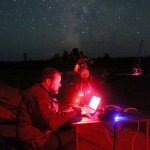
The site is quite remote, no nearby hardware store to replace a missing bolt, no internet connection to allow download of a missing driver. The setup would have to work with what was packed to start with. Several iterations of packing showed that two cases would be required to carry the setup. An ancient hard suitcase I have had since my Air Force days, and a hard equipment case purchased years ago for a portable telescope I have yet to build. At least both had wheels and could be hauled by one person through an airport terminal.
After a few very nice days visiting with my parents I steal away in the camper for the drive to OSP. Four hours sees me over the Cascades, into the Ochoco Mountains east of Prineville. It is a very pleasant drive, a beautiful day, open roads, Mt. Hood soaring over the trees that line the highway. The sort of driving you just can not do on the island, the sort of vacation I grew up with.
The OSP site is quite good, a high ridge with a broad open field on top, set in typical Eastern Oregon dry pine forest. The view is expansive, you can see fourty miles in every direction. There is ample room for the hundreds of campers and motor homes that arrive. Only the last couple miles is gravel road, good gravel road passable to any vehicle including full sized motor homes. Much of the area is fairly level, easy to park and set up telescopes. The ground is rocky, with small sage plants scattered about, just right to stumble over in the dark. The site is also quite dark, no visible lights. A small light dome from Prineville and Bend is visible in my photographs, but not notable to the eye.
The sheer size of the star party is surprising, the crowd of motor homes and campers a bit overwhelming. The organizers report somewhere around 600 people attended OSP this year. Walking the entire event would take half an hour. Not that you could actually do it in that short of time… There is too much to see, unique handmade telescopes, the vendors selling all manner of astro gear, solar scopes offering beautiful views of the Sun. I walk the star party several times, each time finding more, stopping to talk with so many interesting folks.

By some miracle there seems to be nothing critical missing from the setup. No missing bolt or needed cable. Not even a frantic search through the suitcases for a misplaced adapter. It is all here, everything I could bring. The photo rig assembles smoothly, the computer recognizes all of the hardware plugged in. My planning and worry had paid off.
I did have a second telescope available to supplement what fit in the luggage, a little dobson telescope I had made for my parents many years ago. Regallo de Estrellas is a 6″ f/5.4 telescope that is just fun to use. After a tune up, mostly re-collimation, the little ‘scope is used for visual observing while the camera shoots.
Clouds threatened to overtake the first night, a layer of cirrus approaching from the west. While the clouds made for a beautiful sunset they were not welcome. The threat was not realized, the skies clearing not long after dark, leaving a very nice sky for much of the night. Observers who are familiar with the site caution me that the best skies are usually in the dawn hours. Do not give up if the evening conditions are poor.
It took a couple hours of fiddling with the setup to get everything working well, into the dawn the camera was working constantly without any issues. First target of the night was the Iris Nebula, nicely sized for the wide field of view of the TV-76 and 60D setup. I shot the nebula for a couple hours until the camera was about to hit the tripod. Not enough I think, I will need to shoot it a bit more, no worry, there are four more nights. For a second target I setup on the Pleiades for another sequence. This is the plan, one tough target and one easy for each night. The plan is to take advantage of the northerly latitude and shoot targets with high declinations.

Disaster! I forgot the cheese! Two packages of Tillamook cheddar left in my parents refrigerator. I had the sandwich meats, I had to make due with sliced onion, tomato and avocado. There was more than enough food, starvation not an issue. The opposite was closer to the truth, I ate quite well. Meals were simple, sandwiches, chicken breasts cooked in a small fry pan and served in tortillas. Just things I could make up in a few minutes.
One system worked very well indeed. The solar panel on the camper roof was enough to provide all my energy needs. Charging the various computer and camera batteries, as well as charging the large house battery that ran the telescope after dark. Under light cloud the panel can supply several amps, with full sunlight this jumps to over seven amps. My setup takes about one amp to run while taking photos through the night.
Borrowing the camper was not entirely free. The vehicle came with a to-do list. First up was installing an auxiliary input jack for the stereo, my mother wanted to be able to jack in her iPod… Done. I enjoy my own tunes while working on the next chores. Some new DC power jacks are wired directly from the fuse panel. Next was getting the new level meters for the fresh, grey and black water holding tanks working… Done!
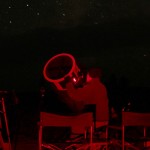
Camped in the same row, Mark Folkerts deployed a 17.5″ dob and a photographic rig. On the other side of me were Ken and Ann Jones, a nice couple with another 18″ dob. Beyond them is Bill Holtzinger, a catholic priest from Grants Pass, using a 14.5″ dob. Through the night I take advantage of their hospitality and enjoy many nice views.
The thunderstorms moved in at sunset on the second evening. Most observers, including me, broke down and covered gear. The rising winds an ominous signal that had many worried about a bad night. All I left out was the mount, not wanting to disturb the polar alignment. It did rain in the night, but the worst did not find us. A couple times through the night I stuck my head out the camper door to a sky of clouds.
A little after three AM it was different, there were stars! No time for photography, the 6″ dob was just the thing for a quick observing session. I hit a few Messier objects, the Veil, and the Pleiades. With dawn arriving, I took a look at Jupiter, watched a few Perseid meteors, just enjoying the quiet morning. The field around me was populated by the ghosts of telescopes, snug under white and silver covers. No other observers stirred to disturb the peaceful scene.

M27 Easy to find off γSge, 2° or the outer telrad ring on the star, bright, large, the eponymous dumbbell shape is quite clear 10′ high by 5′ wide, an outer halo forms a more circular shape around the north-south aligned central region, no color noted, no central star seen
NGC6960 Very easy to find, simply center 52Cyg, quite dim, invisible without the filter, just there with a UHC, a glowing arc straddling the bright 52Cyg, the star interferes with visibility
NGC6992 Easy to locate sweeping from NGC6960, more difficult to see, barely visible without a filter, much better with the UHC in place, quite pretty, a large glowing arc that nearly crosses the field a full degree long, a smooth outer edge is in contrast to the ragged inner edge of the arc
M45 beautiful!! the field is filled with brilliant stars, ten brighter pale blue members punctuate a field dozens, a mottling of nebula is visible around several of the brighter stars
Those who had not awakened at 3am to see stars were somewhat upset with those of us who had enjoyed a few moments of clear skies. Chris enjoined me to throw something at his trailer if I saw stars again while he was sleeping, something heavy and loud. Mark, was a bit more reserved, requested that I tap at his window, he was not renting his trailer.
The remote site has drawbacks, or advantages depending on point of view. There is no 3G signal, no cell, no SMS. The signal could be seen sometimes, flirting at the edge of usefulness. This was not a major issue, I had warned folks I would be out of touch. Eventually I learned that if I set the phone on just the right counter top in the camper kitchen, with the door open, I could get SMS messages through, once in a while. With struggle I managed to get a message or two to my wife, just to say all is good and that I miss her.
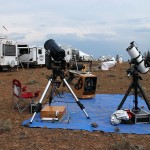
Clouds and lightning again started the third night. Nothing directly upon us, just a few drops of rain and lightning on the horizon. No stars either, just a slight brightening to the west that held a tantalizing hope of clear skies. Most observers checked the covers on their gear and settled in to wait. A wait that was to be rewarded with the sound of steady rain. The next morning I learn that a hole had appeared in the clouds that lasted a couple hours. Chris had knocked at my door. To no avail, I was sound asleep.
One of the great features of Oregon Star Party is the telescope walkabout. Anyone who wishes to attend has a chance to see some great telescopes as the owner demonstrates and discusses the features of the ‘scope. The telescopes on the walkabout are all handmade, many with innovative features. First up, Bob Clements demonstrated a nicely executed 10″ dobsonian with an integral equatorial platform. Chris Tribe dramatically demonstrated the very low weight of his 20″ f/4.5 by lifting the large telescope over his head with ease. Brett Schaerer showed us his WikiKea travel scope, a 6″ that has some ingenious features. The ‘scope gets its name from the Hawaiian word for quick and Ikea, where many of the parts came from. The expanding strut focusing mechanism was particularly innovative. The crowd had plenty of questions and we run well over the allotted time. (More photos of the walkabout can be seen on Mel Bartels website.)
Friday night started with my talk. A mix of a general “about Keck” talk and my adaptive optics talk to throw in something a little more technical. Judging by the compliments I received afterwards it went quite well. Lots of questions, good audience involvement, all things a speaker likes. The common misconception that we use the primary mirror to do adaptive optics showed up again, need to do another blog post on that.

We hoped for clearing in the early morning, much as we had seen on preceding nights. Much to everyone’s surprise it cleared much earlier. By 11pm the entire sky was clear and the telescopes emerged from their cocoons to gaze upon the night. This time it was me who woke Chris up, interrupting his nap to let him know that the clear skies had arrived sooner than expected. One look at the sky and he forgave me the disturbance.
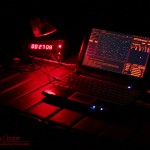

All week we enjoyed a nice display of meteors. With the peak on the 12th the Perseids were expected to be good, and they were, bright fast meteors that often left short lived trains glowing across the sky. We also saw quite a few Delta Aquarids, sometimes challenging the Perseids and producing good fireballs.
With the level meters working I had a much better idea of how much water remains… Almost all of it. Four days of showers and dishes had only consumed a quarter of the supply. My shower that morning is a bit more extravagant, no point hauling the water back over the Cascades. Between the solar panel and the large water tank, I could have camped out twice as long.
The last evening starts much the same. The afternoon sees thunderstorms rolling through. A large storm brushes past the ridge we are camped on, again sparing the telescopes and tents a direct hit. I join a few others in filming the storm, recording impressive lightning and thunder. After the storm is past we spot a fire started in the valley below, a plume of smoke rising five miles away. The Forest Service has noted it too, a spotter aircraft circles the area. We wonder how long it will take for a fire fighting crew to arrive, how thin are the crews spread?
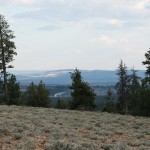
M35 Large, bright, a coarse cluster over 20′ in diameter filling the eyepiece field with stars, fully resolved
NGC1023 Small, faint, a patch of haze about 5′ in diameter, round, brighter to the center
NGC1245 A faint glow betrays a subtle cluster, inspection reveals more stars as the cluster begins to resolve into stars, with the 6″ a nebular glow resists with just a handful of stars visible at the center, about 10′ across and roughly triangular in shape
The last night was to be the best night of the star party. I had a camera in operation from sunset ’til dawn. I gathered more material on the Iris Nebula, shot a few more clusters and star fields. In the morning I dismounted the camera and telescope. In their place I secured the little Canon EOS-M on the mount with a 50mm f1.8 lens to shoot wider starfields.
While cloudy nights in the middle of the week may have hampered the event, a couple good nights to finish made everyone a bit happier. The 2013 Oregon Star Party was over and can be called a success. For me, attending involved a fair amount of effort, packing and hauling a telescope across an ocean. Despite this I was glad to have come. I have cards full of images to process, and memories of dark nights and pretty skies.

